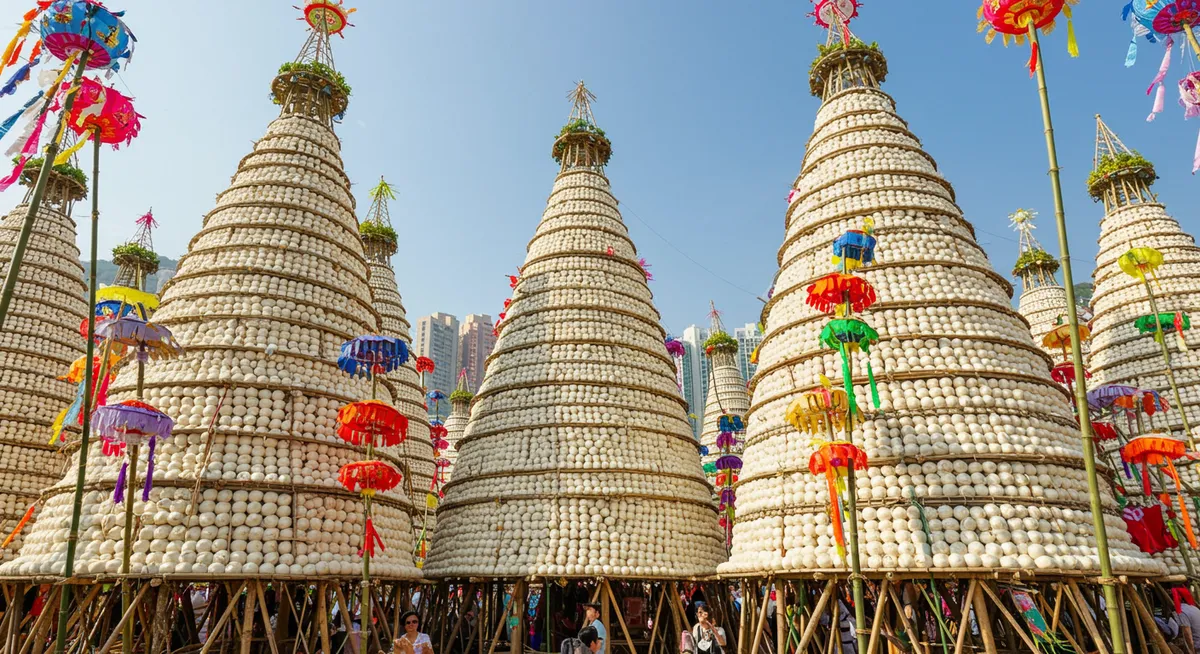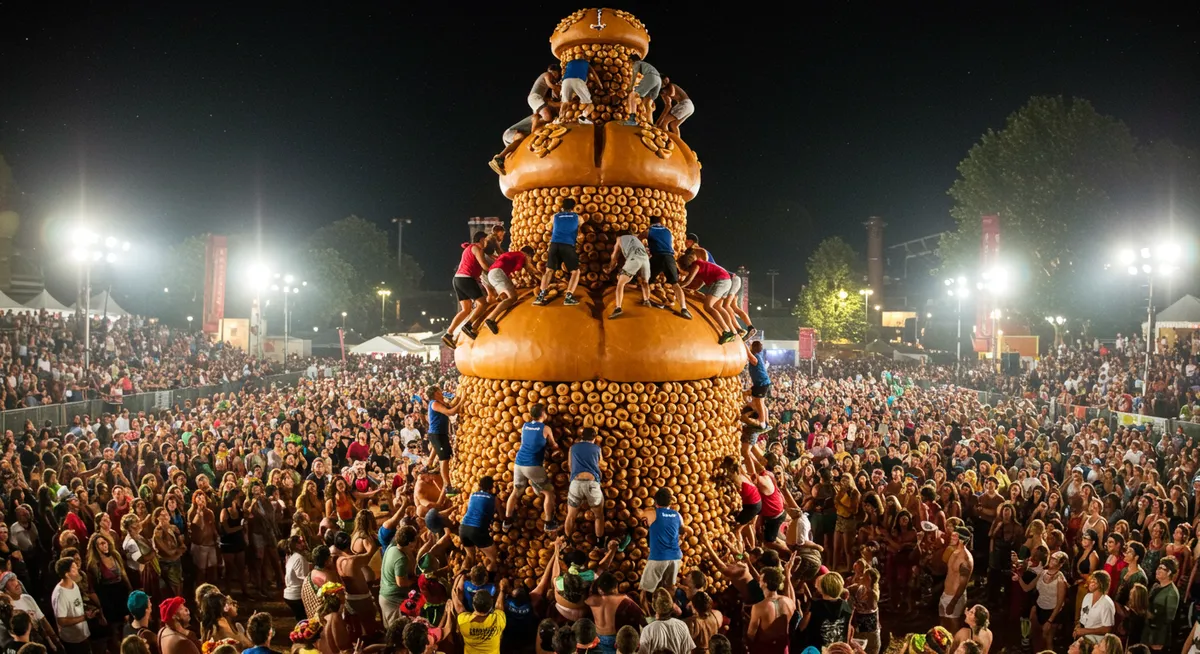Cheung Chau Bun Festival Hong Kong | Iconic Bun Towers & Traditions

Cheung Chau Bun Festival: Hong Kong's Towering Tradition of Protection and Prosperity
On the small, dumbbell-shaped island of Cheung Chau in Hong Kong, an extraordinary centuries-old festival unfolds each spring that transforms this quiet fishing community into one of Asia's most distinctive cultural spectacles. The Cheung Chau Bun Festival (Cheung Chau Da Jiu Festival) combines dramatic Taoist rituals, intricate bamboo towers covered with blessed buns, and colorful parades into an unforgettable celebration that attracts visitors from around the world. This unique tradition showcases Hong Kong's rich heritage where ancient Chinese customs continue to thrive alongside modern city life.

Origins and Spiritual Significance
The Cheung Chau Bun Festival emerged from the island's response to historical tragedy and continues as a ceremony of protection and thanksgiving:
- Plague Origins: According to local tradition, the festival began over 100 years ago after a plague devastated the island's population
- Divine Intervention: Villagers paraded statues of deities to drive away evil spirits, ending the plague
- Pak Tai Veneration: The festival honors Pak Tai (the Northern Emperor), a powerful Taoist deity believed to protect the island
- Community Protection: The rituals aim to ensure safety for fishermen and prosperity for the island community
Key Festival Elements
The Cheung Chau Bun Festival combines several distinctive traditions into a multi-day celebration:
The Iconic Bun Towers
The festival's most famous symbols are the towering bamboo structures covered with buns:
- Sacred Structure: Three bamboo towers reaching approximately 60 feet high are constructed outside Pak Tai Temple
- Blessed Offerings: Thousands of white steamed buns stamped with the Chinese character for "peace" completely cover the towers
- Symbolic Position: Traditionally, the higher a bun is placed on the tower, the more fortune it brings
- Modern Adaptations: After a collapse in 1978, the towers were reinforced with steel, though they maintain their traditional appearance
The Midnight Bun Scramble
Once a wild race up the actual towers, this tradition continues in modified form:
- Traditional Competition: Historically, at midnight, men would race up the towers to collect buns for good fortune
- Modern Competition: Today, selected athletes climb a replica tower in a regulated competition
- Symbolic Gathering: The highest buns are considered most fortunate, creating intense competition
- Scoring System: Competitors collect as many buns as possible within a time limit, with higher buns worth more points

The Parade of Floating Children
One of the festival's most visually striking traditions features "floating" children in historical costumes:
- Historical Representation: Young children dressed as famous figures from Chinese history and mythology
- Elaborate Setup: Children appear to float above the ground, supported by hidden steel frames and accompanied by handlers
- Symbolic Protection: This tradition originated to protect children from evil spirits during the plague
- Intricate Costumes: Elaborate makeup and historical costumes transform children into miniature deities and heroes
Taoist Ceremonies and Rituals
The spiritual heart of the festival involves elaborate Taoist practices:
- Deity Processions: Statues of gods are carried through the island's narrow streets to drive away evil
- Purification Rituals: The entire island follows a vegetarian diet during the festival's peak days
- Temple Offerings: Elaborate presentations of fruit, incense, and traditional items are made at Pak Tai Temple
- Ceremonial Music: Traditional Chinese opera performers and musicians accompany religious ceremonies
Festival Timeline and Traditions
The Bun Festival unfolds over several days according to the lunar calendar:
Pre-Festival Preparations
The community begins preparations weeks in advance:
- Temple Cleaning: Pak Tai Temple undergoes thorough cleansing and decoration
- Tower Construction: Bamboo specialists create the massive bun tower structures
- Bun Production: Local bakeries work around the clock to produce thousands of ceremonial buns
- Parade Rehearsals: Children selected for the floating parade practice balancing and expressions
Festival Opening
The celebration begins with purification rituals:
- Vegetarian Period: The island observes a three-day vegetarian diet to purify the community
- Flag Raising: Ceremonial flags are raised at the temple to mark the beginning of festivities
- Initial Offerings: Community leaders present initial offerings to Pak Tai
- Spirit Pacification: Ceremonies to calm wandering spirits and request protection
Main Festival Day
The climax of celebrations includes several spectacular events:
- Morning Offerings: Elaborate presentations at Pak Tai Temple begin at dawn
- Parade of Floats: The procession featuring "floating children" winds through the island's streets
- Lion and Dragon Dances: Traditional performances to bring good fortune
- Blessing of the Bun Towers: Monks and Taoist priests consecrate the towers
- Midnight Bun Scramble: The climactic competition on the replica tower

Festival Conclusion
The celebrations draw to a close with final rituals:
- Bun Distribution: After the midnight scramble, buns are distributed to the community
- Farewell Ceremony: Rituals thank the deities for their protection
- Tower Dismantling: The bun towers are carefully taken down
- Community Feast: The vegetarian period ends with community celebrations
Experiencing the Bun Festival as a Visitor
For travelers seeking to witness this unique cultural tradition, careful planning enhances the experience:
Practical Travel Information
Navigating the small island during its busiest period requires preparation:
- Festival Timing: Held during the fourth lunar month (usually May), coinciding with Buddha's Birthday
- Getting There: Regular ferries connect Central Hong Kong to Cheung Chau (35-60 minutes depending on ferry type)
- Accommodation: The island has limited hotels and guesthouses that book months in advance
- Crowd Management: The island implements special crowd control measures during peak festival days
- Island Transportation: Cheung Chau is vehicle-free; transportation is by foot or bicycle
Visitor Etiquette
Respectful participation enhances both your experience and local appreciation:
- Temple Respect: Observe appropriate behavior in Pak Tai Temple, including modest dress
- Photography Considerations: Ask permission before photographing ceremony participants
- Dietary Awareness: Consider observing the vegetarian tradition during your visit
- Crowd Courtesy: Be mindful of local residents during the busy festival period
- Cultural Appreciation: Take time to learn about the ceremonies' significance beyond the spectacle
Beyond the Main Events
The festival offers experiences beyond the headline attractions:
- Traditional Opera: Performances of Cantonese opera on temporary bamboo stages
- Cultural Exhibitions: Displays explaining the festival's history and significance
- Craft Demonstrations: Traditional artisans showcase skills like paper cutting and bun making
- Local Cuisine: Special vegetarian festival foods available throughout the island
- Island Exploration: Hiking trails and beaches offer respite from festival crowds
Cultural Significance and Heritage Preservation
The Bun Festival represents a living link to Hong Kong's pre-modern past:
- Intangible Cultural Heritage: Recognized on China's national heritage list since 2011
- Community Identity: A source of pride and continuity for Cheung Chau residents
- Rural-Urban Connection: Maintains traditional practices within modern Hong Kong
- Transmission to New Generations: Deliberate efforts to involve young people in festival traditions
- Tourism Balance: Community efforts to preserve authenticity while welcoming visitors
Plan your Bun Festival experience
For the best experience, consider arriving on Cheung Chau a day before the main celebrations to explore the island and witness preparations.
The Hong Kong Tourism Board provides updated festival schedules each year, as lunar calendar dates vary annually.
Explore More Asian Cultural Festivals
If you're fascinated by the Cheung Chau Bun Festival, discover other extraordinary Asian festivals that showcase the continent's rich cultural heritage:
Dragon Boat Festivals
Another iconic Hong Kong celebration with thrilling boat races and rice dumplings.
Vesak: Buddha Day
Buddhism's most sacred festival celebrating Buddha's birth, enlightenment, and passing.
Gion Matsuri
Japan's spectacular month-long festival with elaborate float processions.
Songkran Water Festival
Thailand's joyous celebration with water purification ceremonies.
Holi Festival
India's vibrant spring festival with colorful powder celebrations.
Hanami
Japan's beloved cherry blossom viewing tradition celebrating spring.
Return to our Asian Cultural Festivals Guide to discover more extraordinary celebrations across the continent.